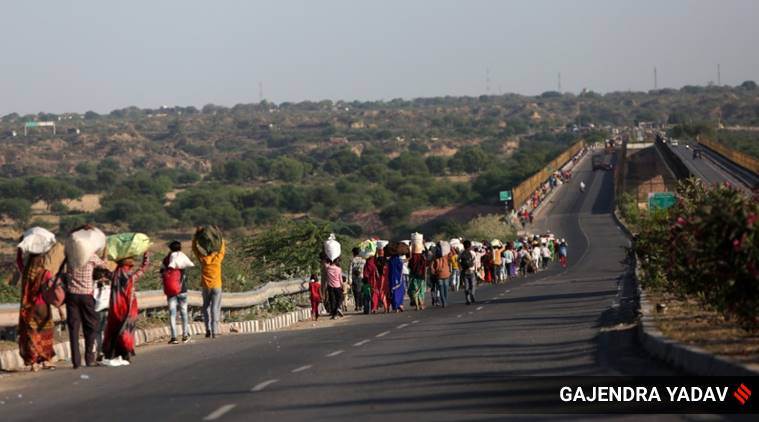 Lakhs of migrant labourers had to walk homes when a nationwide lockdown was announced to contain the spread of novel coronavirus (Express Photo by Gajendra Yadav/File)
Lakhs of migrant labourers had to walk homes when a nationwide lockdown was announced to contain the spread of novel coronavirus (Express Photo by Gajendra Yadav/File)
By now, we have all read about how unprecedented a crisis Covid-19 is — so I wish to get straight to the main issues, and possible solutions. We need to simplify our communication, present a sustainable plan and, above all, implement. Yes, we must continue testing, but I feel that we are sorely lacking in implementation.
There is no questioning the wisdom of Prime Minister Narendra Modi’s strategy in ensuring a complete lockdown. While the Centre, RBI and states have announced a slew of good plans, why do we still hear of the stoning of doctors, the lack of following of the rules, non-availability of essential food and money for the poor. For me, the answer lies in inadequate communication and implementation. While we all must work in unified fashion, the main onus lies with our elected representatives, right down to the MLA. It is time they earned their votes and the trust that their constituents have placed in them. They must appear at least once a week before the public, after donning masks and gloves and adhering to social distancing norms, to explain in simple terms the government’s policies. As the situation is dynamic, they must continuously update the general public of the changes. Making appearances on TV and giving instructions is not enough.
This is the need of the hour. Because the void of information is quickly filled by speculations and rumours, mainly through social media. Leon Festinger’s theory of cognitive dissonance basically explains that people tend to look for consonance in their action — right or wrong. For instance, we are well-aware of the fact that smoking leads to cancer, but smokers bring about ill-advised consonance by following any 80-year-old doctor who smokes and has no cancer. And so it is, that when some MLAs, MPs and self-proclaimed leaders have weddings, and break the rules as VIPs, the average person wonders, “why can’t i?” — thus bringing about consonance to their wrong actions.
The eminent virologist Ian Lipkin has said that complete normalcy will return to the world after a vaccine is developed, which is about a year away. The economy, though, is floundering. So what do we do in the meantime other than communicate as outlined? We should have a very short-term plan (three months) and a short-term plan (nine months), that will need to be frequently reviewed.
The very short term plan involves the government having transparent discussions. All meetings that the prime minister has with the chief ministers should be open — like in Parliament. The people are eager to hear not only what the prime minister has to say, but what their chief ministers are planning. Agriculture must be given the top priority – buying of farmers’ goods, their transportation and storage. Export oriented industries need to be opened up. White-collar workers can work from home, but not the blue-collar workers. They are the backbone of the economy. Migrant workers are grappling with no income and crowded living conditions — with rents to pay and not enough food. They must be provided these basic survival resources. It will be difficult to get these workers back from their homes when the economy opens up. The current Rs 500 per month is not enough, and this should be increased to at least Rs 3,000. The total cost for this entire exercise would not be very high — about Rs 50,000 crore. This is a small price to pay when one considers alternate scenarios which may be disastrous.
In the short-term, a fiscal stimulus needs to be given directly to the rural areas, and taxes must be reduced for the middle-income group to incentivise them to spend and generate the much-needed demand. Stimulus must also be given to the MSMEs in order for them to pay their wages and reopen their operations. Lastly, support must also be given to large industries to open up with specific guidelines, but without any draconian laws or many impediments for either new or existing industries: Nobody will open up or enter if fear is drilled into them.
Where will the money for all of the above come from? We must empower the states to act within the broad guidelines framed by the Centre which cannot, and must not act as a police force. If alcohol is an income source, then let the states decide on it. The Centre spends far too little as a percentage of GDP when compared to other countries. Any stimulus must focus on the rural areas and the middle-income groups to not only tide over the crisis, but also generate demand to kickstart the virtuous cycle. Industry will not produce anything without demand, even if it is opened.
As the PM said, “Jaan Hai toh Jahan Hai”. The time has come to follow his motto in letter and spirit. A lot of the building blocks have been put in place by the PM. If a new stimulus package manages to keep/bring back workers, it will be an opportunity for us to get back on the path of growth. States, industry and citizens — all of us must support and act as Indians. The future is in our hands and our efforts can make all the difference between jannat (heaven) and jahannum (hell).
This article first appeared in the print edition on April 30 under the title “The ways out”. The writer is a business consultant